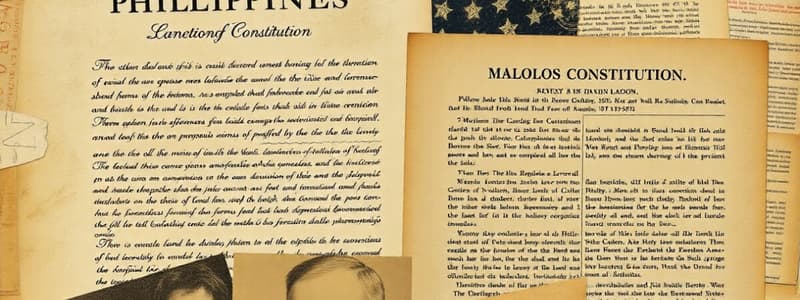Podcast
Questions and Answers
What is the primary responsibility of the Civil Service Commission as outlined in the 1987 Constitution?
What is the primary responsibility of the Civil Service Commission as outlined in the 1987 Constitution?
- Regulating election laws
- Drafting constitutional amendments
- Managing government personnel (correct)
- Examining government funds and transactions
Which body is responsible for enforcing election laws in the Philippine government structure?
Which body is responsible for enforcing election laws in the Philippine government structure?
- The Office of the President
- The Department of Justice
- The Senate
- The Commission on Elections (correct)
What role does the Commission on Audit play in the Philippine government?
What role does the Commission on Audit play in the Philippine government?
- Provides legal advice on governance
- Conducts polling for elections
- Oversees civil service reforms
- Examines government funds and transactions (correct)
Which of the following correctly lists a part of the legislative structure under the 1987 Constitution?
Which of the following correctly lists a part of the legislative structure under the 1987 Constitution?
When was the draft of the Constitution endorsed that ultimately shaped the current Philippine governance?
When was the draft of the Constitution endorsed that ultimately shaped the current Philippine governance?
Flashcards
1987 Constitution
1987 Constitution
The current constitution of the Philippines.
Executive branch
Executive branch
The part of the government responsible for enforcing laws.
Civil Service Commission
Civil Service Commission
The government agency overseeing personnel.
Commission on Elections
Commission on Elections
Signup and view all the flashcards
Commission on Audit
Commission on Audit
Signup and view all the flashcards
Study Notes
1899 Malolos Constitution
- The preface of the 1899 Malolos Constitution expresses a desire for justice, common defense, general welfare, and liberty, with the help of a supreme legislator.
- The document envisioned a vote-based government.
- Two wars preceded the Malolos Congress: Philippine Revolution (August 23, 1896 – August 13, 1898) and the Spanish-American War (April 21, 1898 – August 13, 1898).
- The constitution aimed to establish a representative government, including a Bill of Rights, separation of church and state, and a single-chamber legislature.
- The type of government outlined as popular, representative, alternative and responsible.
- Emilio Aguinaldo declared the Philippine Republic on January 23, 1899, highlighting the contrast between Philippine and US freedoms.
1935 Constitution
- It was enacted after the Treaty of Paris, establishing a period of military governance.
- The Philippine Organic Act of 1902 led to the formation of the Philippine Assembly.
- The Jones Law established a bicameral legislature including the Philippine Commission (upper house) and the Philippine Assembly (lower House).
- Principles including a Bill of Rights.
- The 1935 Constitution established the Philippine Commonwealth, which served as the transitional government.
- It created a system with a President and a four-year term.
1973 Constitution
- Ferdinand Marcos implemented a new constitution amidst Martial Law in 1972.
- The constitution gave the President considerable power, potentially for prolonged periods.
- This constitution was disputed.
- Marcos was overthrown, giving way to Corazon Aquino.
1987 Constitution.
- Corazon Aquino sought a new constitution.
- This document sought to correct issues with previous constitutions and solidify democratic principles.
- The constitution aimed genuinely to reflect the Filipino people's desires.
- Proposed as a transitional constitution lasting for 1 year while a new one was drafted.
- It includes an executive branch led by the president and a legislative branch divided into two houses.
Constitutional Framework
- Emergency Powers: The President can declare martial law for up to 60 days, which can be reviewed by Congress.
- Legislative Branch: Composed of the Senate and House of Representatives, with specific terms for the representatives.
- Judicial Branch: The Supreme Court, along with other lower courts, oversees the judicial system. Independent bodies check on these branches.
Studying That Suits You
Use AI to generate personalized quizzes and flashcards to suit your learning preferences.




